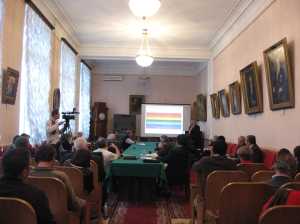ST. PETERSBURG STATEMENT ON THE ARAL SEA

An international conference on the Aral Sea was held in St. Petersburg from 12 to 15 October 2009. The conference was devoted to the Aral: Past, Present and Future and to two centuries of Aral Sea investigations. The statement below is based on the presentations and discussions at this meeting. You can see photo and video report here.
It represents the consensus of thought on the Aral Sea issue and has been reviewed and commented upon by many of the participants as well as several experts not at the conference.
- The Aral Sea, a once large terminal lake lying in the deserts of Central Asia, has undergone unprecedented shrinking and salinization since the 1960s. These processes have had serious negative ecologic impacts on the lake and deltas of its two influent rivers. The people living around the lake have also suffered from the sea's destruction that has worsened environmental and health conditions, devastated local economies, and led to social and cultural disruption.
- In order to place the modern (post 1960) recession in context, it is essential to understand that the lake has experienced repeated recessions and transgressions since it most recent geological incarnation some 10,000 years ago. These have resulted from natural climate change, development of irrigation in the lake's basin during the past 4,000 years, and repeated shifts of the major influent river (the Amu Dar'ya) from the Aral westward to the Caspian Sea and then back again to the Aral. The last factor, caused by both natural and human forces, appears to have been the primary cause of deep recessions, the most recent of which occurred during medieval times (13th to 16th Centuries).
- The modern (post 1960) recession is different than its predecessors. For the first time irrigation is the dominant force driving a major recession rather than diversion of the Amu River away from the lake. This desiccation is the most severe for at least several thousand years and soon will become the greatest in the last 10 millennia. The chief factor leading to the modern drying of the Aral was the expansion of irrigation in the sea's drainage basin from the mid-1950s to the mid 1980s that went well beyond the point of sustainability, causing a marked decline of river inflow to the lake. Primarily irrigation and secondarily natural climatic cycles have been the dominant cause of the modern drying of the Aral. Global warming in recent decades has started to influence the water balance of the Aral and will become a more important factor in the future; however, it has not been a major cause of the Aral's desiccation to this time.
- Diversion (redirection) of Siberian rivers southward to the Aral Sea Basin or the pumping of water from the Caspian to the Aral are not realistic options for solving water problems in Central Asia. They would be too expensive and complicated, would require complex international agreements, and have too many potentially serious environmental consequences. It would be wiser to focus on local and regional solutions to these key issues such as improved efficiency of water use in irrigation and efforts to preserve and partially restore remaining parts of the Aral Sea.
- The Aral Sea depends on the Amu and Syr rivers for its water. This inflow in turn is the key factor determining both the lake's size and ecological quality. Hence, an urgent necessity is proper management of the water resources of the Aral Sea drainage basin. This requires cooperation and collaboration among the basin states to solve the critical problems of water management, including water sharing, and the conflicts arising between the upstream and downstream states over the needs of irrigation versus maximization of hydropower output. The most important measure is widespread introduction of modern technologies and methods of irrigated agriculture as part of a program for reconstruction of outdated, inefficient irrigation systems. This would promote reduction of water withdrawals by the countries of the Aral Sea Basin and free water for the Aral Sea, which would aid in the restoration of that water body's unique biota. Working and lobbying for agricultural reform and rational water use is necessary at all levels of government and society in the Central Asian nations - from the individual user to decision-makers. This process must involve specialists as well as social-ecological organizations, associations and activist groups.
- There is a long and rich history of Aral Sea studies dating from the middle of the 19th Century. Many high-quality, careful and scientifically sound investigations took place during the Russian Empire and the subsequent Soviet Union and resulted in a plethora of excellent scientific publications. Contemporary research and researchers should not ignore the valuable scientific contributions made during these periods.
- Reports of the Aral Sea's death are premature. Although the Aral Sea of the 1960s is gone for the foreseeable future, sizable parts of the lake remain. The Small (north) Aral Sea has been partially, and so far very successfully, restored so that it again has significant ecological and economic value. Although the Eastern Basin of the Large Aral is lost, the Western Basin could be partially preserved and restored, if studies show this to be economically and environmentally feasible. Laudable efforts are also underway to protect and preserve parts of the Syr and Amu Dar'ya deltas.
- A new research approach is essential for the study of the Aral Sea, river deltas and surrounding region. It must be a balance of theoretical and applied science and involve collaboration of scientists from different disciplines and as many countries as possible. Special efforts must be made to attract and engage younger scientists and researchers in order to secure long-term scientific commitment and continued international dialogue. IFAS (International Fund for Saving the Aral Sea) must co-operate with leading scientists from all countries of the world.
- An international committee for interdisciplinary ecological monitoring and research on the Aral Sea needs to be established. Its focus should be to develop a comprehensive view of the ecosystems of the lake and immediate surrounding zone (especially the deltas of the two influent rivers). The charge of the committee should be analysis of available data as background for design of measures to improve ecological conditions and water management methods for the Aral Sea and its drainage basin. The Committee should give careful consideration to the ideas for improving the situation of the Aral Sea and near Aral region developed by the International Working Group of the United Nations Environment Program (composed of Western and Soviet experts) from 1990-1992. It also needs to coordinate and cooperate with the existing IFAS (International Fund for Saving the Aral Sea and the Near Aral Region) to avoid duplication of effort, to ensure the most effective use of international donor funds, and to avoid interfering with the valuable work of this organization. The Committee should include scientists from a diversity of relevant disciplines, including, but not limited to, limnology, terrestrial ecosystems ecology, geography, geology, botany and zoology, ornithology, hydrology, agronomy, soil sciences, meteorology, historical sciences (anthropology, archeology, history), economics, and ichthyology. It is of critical importance to include local politicians and administrators as well as representatives from public bodies such as NGOs, and other stakeholders on the committee. A research team composed of experts from the Aral Sea region should also be established to carry out a long-term research master plan. As a key part of this effort, funding must be provided for the construction of a modern, well-equipped laboratory at an appropriate location in the Aral Sea Basin. Since many useful and pertinent raw data are fairly inaccessible (e.g., found on handwritten charts and the like) a concerted effort is essential to convert such data to easily accessible digital format. This would improve access to the data and would enable greater participation from the world scientific community






